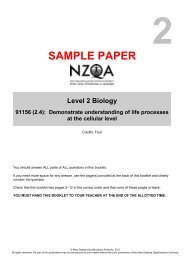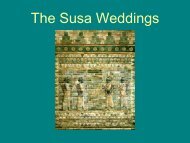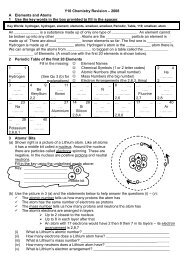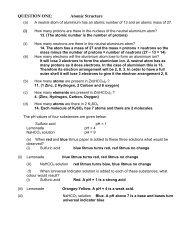Genetics Biology Worksheet QUESTIONS
Genetics Biology Worksheet QUESTIONS
Genetics Biology Worksheet QUESTIONS
You also want an ePaper? Increase the reach of your titles
YUMPU automatically turns print PDFs into web optimized ePapers that Google loves.
QUESTION ONE: DNA AND VARIATION<br />
Genes determine many of the features of organisms, such as the<br />
colour of the flowers on a plant.<br />
A gene is a part of a DNA molecule.<br />
The type of plant shown in the photograph below can have red or<br />
white flowers.<br />
QUESTION TWO: SEXUAL REPRODUCTION<br />
Meiosis is a particular form of cell division that produces male and<br />
female gametes.<br />
(a)<br />
Describe what gametes are and explain why they are needed<br />
for sexual reproduction.<br />
Meiosis contributes to genetic variation.<br />
Red flowers are due to a dominant allele and white flowers are due<br />
to a recessive allele.<br />
Discuss how information in DNA gives organisms (like the plant<br />
above) their individual features, such as red and white flowers. In<br />
your answer, you should:<br />
explain the difference between a gene and an allele<br />
draw a labelled diagram to show the relationship between a gene<br />
and an allele and the structure of a DNA molecule<br />
explain how the base sequence on DNA determines a particular<br />
feature (eg, flower colour) and different forms (variations) of that<br />
feature (eg, red and white flowers)<br />
(b)<br />
Discuss how meiosis contributes to genetic variation, and why<br />
genetic variation is important in a population. In your answer,<br />
you should:<br />
describe what is meant by genetic variation<br />
explain how the process of meiosis leads to genetic<br />
variation<br />
explain why genetic variation is of benefit to a population<br />
You could draw labelled diagrams to support your answer.
QUESTION THREE: MONOHYBRID CROSSES<br />
The allele for a cleft chin (D) is dominant over the allele for a<br />
smooth chin (d).<br />
The pedigree diagram below shows the chin types in a family.<br />
(c)<br />
Individuals A and B, as shown on the pedigree diagram,<br />
decide to have another child. They draw a Punnett square to<br />
find what type of chin their child might have.<br />
Explain why the result predicted by the Punnett square may<br />
not accurately tell them what type of chin their child will have.<br />
In your answer, you should:<br />
draw a Punnett square to show the cross between<br />
individual A and individual B<br />
determine the probabilities of the child having a cleft chin<br />
and having a smooth chin<br />
explain why the ratio of children born into the family with<br />
cleft and smooth chins may not match the probabilities.<br />
(a)<br />
(b)<br />
Explain how evidence in the pedigree diagram shows that the<br />
cleft chin allele (D) is dominant over the smooth chin allele (d).<br />
In your answer, you should:<br />
Describe what the term dominant allele means<br />
draw a Punnett square(s) to show your reasoning.<br />
Explain why the genotype of male A in generation 2 of the<br />
pedigree diagram must have the genotype Dd.
QUESTION FOUR: SURVIVAL<br />
Mutations can occur in DNA during cell division.<br />
Explain whether a mutation could be inherited if it occurred in a skin<br />
cell of an individual. In your answer, you should:<br />
describe what a mutation is<br />
explain what determines whether a mutation is able to be<br />
inherited or not.<br />
QUESTION SIX: VARIATION<br />
A population of plants, species A, living in a certain area shows a<br />
lot of variation in its leaf size, from very small to very large as<br />
shown in the graph below.<br />
Leaf size of plants of species A<br />
QUESTION FIVE: GENETICS<br />
Explain how two parents who don’t show a particular characteristic<br />
can have a child who does show that feature.<br />
In your answer include:<br />
The nature of the characteristic<br />
What causes a feature to be expressed (shown)<br />
What is different (genetically) between the parents and the child<br />
Leaf size affects the ability of a plant to absorb sunlight and make<br />
food. Plants with larger leaves can live in areas with lower light<br />
levels.<br />
A new plant, species B, starts growing in the same area as<br />
species A. Species B plants grow taller than species A plants,<br />
which reduces the light available to plants growing below species<br />
B.<br />
Discuss how variation in leaf size occurs in the starting population<br />
of species A and explain how this might help species A to survive<br />
when species B starts growing in the same area.<br />
In your answer, you should consider:<br />
what causes variation within a population<br />
the effect of reduced light on different individuals of plant<br />
species A
QUESTION SEVEN: GENETICS<br />
Cloning involves making an exact copy of an organism. Selective<br />
breeding involves the breeding together of organisms that possesses<br />
highly desirable characteristics.<br />
Compare and contrast selective breeding and cloning.<br />
Your answer should include<br />
How the offspring compare to their parents<br />
Their relative advantages and disadvantages<br />
QUESTION EIGHT: GENETICS<br />
There are many genes used by pedigree cat breeders to get a range of<br />
colours, fur length and body shapes. Several genes can control coat<br />
colour in cats.<br />
One of these produces the Agouti pattern, where each hair has a black tip<br />
but bands of light and dark towards the hair root. This causes a cat to<br />
have a striped appearance. This pattern is dominant, and denoted by the<br />
letter A. The recessive allele for this trait gives plain black hairs.<br />
(a)<br />
A breeder wishes to have a pure breeding group with the Agouti<br />
coat colour. He has a group of the Oriental breed pictured above,<br />
some of which are black and some of which are Agouti.<br />
Discuss how he would go about developing a pure breeding<br />
Agouti group. Include punnet square(s) in your answer.<br />
In the future it may be possible for breeders to simply sell copies of a<br />
cloned Agouti cat rather than rely on selective breeding. Cloning involves<br />
taking a cell from the parent and making an identical copy of the parent.<br />
The genetic characteristics of the animals obtained by these two breeding<br />
techniques will be different.<br />
(b) Discuss the reasons for the differences in the genetic characteristics<br />
of the cats produced by selective breeding and cloning. In your<br />
answer you should:<br />
Consider the type of cell division<br />
involved in each breeding technique.<br />
Variation (or lack of it) in the offspring

















